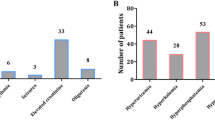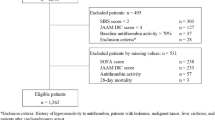Abstract
Background
Few studies have examined disseminated intravascular coagulation (DIC) in childhood acute lymphoblastic leukemia (ALL). Our aims were to evaluate the prevalence, risk factors and outcomes of DIC at ALL presentation and during induction chemotherapy.
Methods
The medical records of ALL patients aged <15 years were retrospectively reviewed. Logistic regression analysis was used to identify risk factors. The Kaplan–Meier method was used to depict survival.
Results
Of the 312 patients, 48 (15.4%) and 76 (24.4%) had DIC at presentation and during induction chemotherapy, respectively. Risk factors for DIC at presentation (OR and 95% CI) were antibiotics prior to admission 2.34 (1.17–4.89), white blood cell count ≥100 × 109/L 2.39 (1.04–5.72), platelets <100 × 109/L 5.44 (1.84–23.4) and high National Cancer Institute (NCI) risk 2.68 (1.08–6.62). Risk factors for DIC during induction chemotherapy were antibiotics prior to admission 1.86 (1.07–3.27), high peripheral blasts 1.01 (1.00–1.02) and transaminitis 2.02 (1.18–3.48). Five-year overall survival of patients who had DIC was significantly lower than those who did not (45.0% vs. 74.1%, p <0.001).
Conclusion
Antibiotics prior to admission, hyperleukocytosis, thrombocytopenia and high NCI risk were risk factors of DIC at presentation. Antibiotics prior to admission, high peripheral blasts and transaminitis were risk factors of DIC during induction chemotherapy.
Impact
-
There are only two studies, both published before 2000, evaluating risk factors of DIC in pediatric ALL patients without reporting outcomes.
-
DIC was associated with lower remission and survival rates in pediatric ALL patients. We identified the risk factors of DIC at presentation as antibiotics prior to admission, hyperleukocytosis, thrombocytopenia and high NCI risk. The risk factors of DIC during induction chemotherapy were antibiotics prior to admission, high peripheral blasts and aspartate transaminitis.
-
Pediatric ALL patients who have the aforementioned risk factors should be closely monitored for DIC secondary to infection, and early treatment with appropriate antimicrobial agents is recommended.
This is a preview of subscription content, access via your institution
Access options
Subscribe to this journal
Receive 14 print issues and online access
$259.00 per year
only $18.50 per issue
Buy this article
- Purchase on Springer Link
- Instant access to full article PDF
Prices may be subject to local taxes which are calculated during checkout

Similar content being viewed by others
Data availability
The data that support the findings of this study are available on reasonable request from the corresponding author. The data are not publicly available due to privacy or ethical restrictions.
References
Taylor, F. B. et al. Towards definition, clinical and laboratory criteria, and a scoring system for disseminated intravascular coagulation. Thromb. Haemost. 86, 1327–1330 (2001).
Rajagopal, R., Thachil, J. & Monagle, P. Disseminated intravascular coagulation in paediatrics. Arch. Dis. Child. 102, 187–193 (2017).
Higuchi, T. et al. Disseminated intravascular coagulation in acute lymphoblastic leukemia at presentation and in early phase of remission induction therapy. Ann. Hematol. 76, 263–269 (1998).
Nur, S., Anwar, M., Saleem, M. & Ahmad, P. A. Disseminated intravascular coagulation in acute leukaemias at first diagnosis. Eur. J. Haematol. 55, 78–82 (1995).
Sarris, A. et al. High incidence of disseminated intravascular coagulation during remission induction of adult patients with acute lymphoblastic leukemia. Blood 79, 1305–1310 (1992).
Sarris, A. et al. Disseminated intravascular coagulation in adult acute lymphoblastic leukemia: frequent complications with fibrinogen levels less than 100 mg/dl. Leuk. Lymphoma 21, 85–92 (1996).
Törnebohm, E., Lockner, D. & Paul, C. A retrospective analysis of bleeding complications in 438 patients with acute leukaemia during the years 1972-1991. Eur. J. Haematol. 50, 160–167 (1993).
Chojnowski, K., Wawfuyniak, E., Treilinski, J., Niewiarowska, J. & Cierniewski, C. Assessment of coagulation disorders in patients with acute leukemia before and after cytostatic treatment. Leuk. Lymphoma 36, 77–84 (1999).
Dixit, A. et al. Disseminated intravascular coagulation in acute leukemia at presentation and during induction therapy. Clin. Appl. Thromb. 13, 292–298 (2007).
Higuchi, T. et al. Disseminated intravascular coagulation complicating acute lymphoblastic leukemia: a study of childhood and adult cases. Leuk. Lymphoma 46, 1169–1176 (2005).
Guo, Z., Chen, X., Tan, Y., Xu, Z. & Xu, L. Coagulopathy in cytogenetically and molecularly distinct acute leukemias at diagnosis: comprehensive study. Blood Cells Mol. Dis. 81, 102393 (2020).
Sletnes, K. E., Godal, H. C. & Wisløff, F. Disseminated intravascular coagulation (DIC) in adult patients with acute leukaemia. Eur. J. Haematol. 54, 34–38 (1995).
Ribeiro, R. C. & Pui, C. H. The clinical and biological correlates of coagulopathy in children with acute leukemia. J. Clin. Oncol. 4, 1212–1218 (1986).
Padungmaneesub, W. et al. Biomarkers of disseminated intravascular coagulation in pediatric intensive care unit in Thailand. Int. J. Lab. Hematol. 41, 32–38 (2019).
Jhang, W. K. & Park, S. J. Evaluation of disseminated intravascular coagulation in critically ill pediatric hemato-oncology patients with septic shock. Thromb. Haemost. 120, 1505–1511 (2020).
Kittivisuit, S. et al. Musculoskeletal involvement in childhood leukemia: characteristics and survival outcomes. Pediatr. Rheumatol. Online J. 20, 34 (2022).
Winick, N. et al. Impact of initial CSF findings on outcome among patients with National Cancer Institute standard- and high-risk B-cell acute lymphoblastic leukemia: a report from the Children’s Oncology Group. J. Clin. Oncol. 35, 2527–2534 (2017).
Kong, S. G., Seo, J. H., Jun, S. E., Lee, B. K. & Lim, Y. T. Childhood acute lymphoblastic leukemia with hyperleukocytosis at presentation. Blood Res. 49, 29 (2014).
Smith, M. et al. Uniform approach to risk classification and treatment assignment for children with acute lymphoblastic leukemia. J. Clin. Oncol. 14, 18–24 (1996).
Tubergen, D. G. et al. Improved outcome with delayed intensification for children with acute lymphoblastic leukemia and intermediate presenting features: a Childrens Cancer Group phase III trial. J. Clin. Oncol. 11, 527–537 (1993).
Lauer, S. et al. A comparison of early intensive methotrexate/mercaptopurine with early intensive alternating combination chemotherapy for high-risk B-precursor acute lymphoblastic leukemia: a Pediatric Oncology Group phase III randomized trial. Leukemia 15, 1038–1045 (2001).
Seibel, N. L. et al. Early postinduction intensification therapy improves survival for children and adolescents with high-risk acute lymphoblastic leukemia: a report from the Children’s Oncology Group. Blood 111, 8 (2008).
Bostrom, B. C. et al. Dexamethasone versus prednisone and daily oral versus weekly intravenous mercaptopurine for patients with standard-risk acute lymphoblastic leukemia: a report from the Children’s Cancer Group. Blood 101, 3809–3817 (2003).
Barbui, T. & Falanga, A. Disseminated intravascular coagulation in acute leukemia. Semin. Thromb. Hemost. 27, 12 (2001).
Franchini, M., Dario Di Minno, M. & Coppola, A. Disseminated intravascular coagulation in hematologic malignancies. Semin. Thromb. Hemost. 36, 388–403 (2010).
Takemitsu, T. et al. Prospective evaluation of three different diagnostic criteria for disseminated intravascular coagulation. Thromb. Haemost. 105, 40–44 (2011).
Wada, H., Matsumoto, T. & Yamashita, Y. Diagnosis and treatment of disseminated intravascular coagulation (DIC) according to four DIC guidelines. J. Intensive Care 2, 15 (2014).
Kunwar, S. et al. Diagnostic scores and treatment options for acute disseminated intravascular coagulation in children. Cureus 13, e17682 (2021).
Acknowledgements
We would like to thank Dave Patterson of the Office of International Affairs, Faculty of Medicine, Prince of Songkla University for his English editing.
Author information
Authors and Affiliations
Contributions
N.S., S.C., P.S., E.M. and T.C. made substantial contributions to conception and design, acquisition of data, or analysis and interpretation of data. N.S. and T.C. were primarily responsible for drafting and revising the manuscript for important intellectual content. All authors provided final approval of the manuscript to be submitted for publication.
Corresponding author
Ethics declarations
Competing interests
The authors declare no competing interests.
Additional information
Publisher’s note Springer Nature remains neutral with regard to jurisdictional claims in published maps and institutional affiliations.
Rights and permissions
Springer Nature or its licensor (e.g. a society or other partner) holds exclusive rights to this article under a publishing agreement with the author(s) or other rightsholder(s); author self-archiving of the accepted manuscript version of this article is solely governed by the terms of such publishing agreement and applicable law.
About this article
Cite this article
Songthawee, N., Chavananon, S., Sripornsawan, P. et al. Prevalence and risk factors of disseminated intravascular coagulation in childhood acute lymphoblastic leukemia. Pediatr Res 94, 588–593 (2023). https://doi.org/10.1038/s41390-023-02475-8
Received:
Revised:
Accepted:
Published:
Issue Date:
DOI: https://doi.org/10.1038/s41390-023-02475-8



